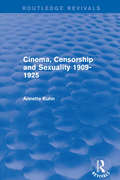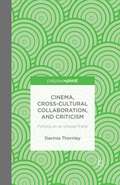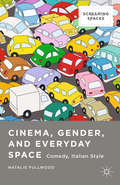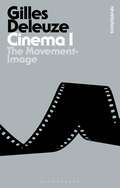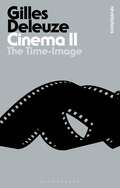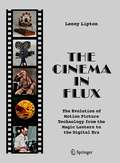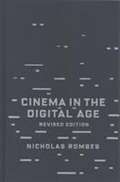- Table View
- List View
Cinéma brut: Eine alternative Genealogie der Filmavantgarde (Edition Angewandte)
by Gabriele JutzBis heute schwingt im Begriff der Filmavantgarde der Gedanke mit, ein Film sei umso avantgardistischer, je „reiner" er sei - je mehr er seine medienspezifische Bedingtheit, seine "Essenz" inszeniere und sich von anderen Künsten „befreie". Diesem modernistischen Diskurs des Purismus, der sich auch in der aktuellen post-medium condition hartnäckig hält, antwortet die vorliegende Studie mit einer alternativen Phänomenologie und Genealogie des Avantgardefilms, die nicht das Reine, sondern das „Unreine" zum Maßstab nimmt. Mit der expanded-cinema-Aktion, dem handmade- und dem found-footage-Film stellt die Autorin dem cinéma pur ein cinéma brut gegenüber, dessen Dispositive und Praktiken sich am Schmutzigen, an Formverlust und Grenzüberschreitung orientieren. Ausgehend von kunst- und kulturtheoretischen Debatten um Materialität und Performanz, Index und Spur, werden zunächst Grundzüge des cinéma brut systematisiert, und in einem zweiten Schritt, anhand exemplarischer Analysen, Eckpunkte einer „unreinen" Geschichte der europäischen und nordamerikanischen Filmavantgarde markiert.
Cinema by Other Means
by Pavle LeviCinema by Other Means explores avant-garde endeavors to practice the cinema by using the materials and the techniques different from those commonly associated with the cinematographic apparatus. Using examples from both the historical and the post-war avant-garde -- Dada, Surrealism, Letterism, "structural-materialist" film, and more -- Pavle Levi reveals a range of peculiar and imaginative ways in which filmmakers, artists, and writers have pondered and created, performed and transformed, the "movies" with or without directly grounding their work in the materials of film. The study considers artists and theorists from all over Europe --- France, Italy, Soviet Union, Germany, Hungary -- but it particularly foregrounds the context of the Yugoslav avant-garde. Cinema by Other Means offers the English-language reader a thorough explication of an assortment of distinctly Yugoslav artistic phenomena, such as the Zenithist cine-writings of the 1920s, the proto-structural Antifilm movement of the early 1960s, and the "ortho-dialectical" film-poetry of the 1970s.
Cinema, Censorship and Sexuality 1909-1925 (Routledge Revivals)
by Annette KuhnFirst published in 1988. This book shows how censorship as a set of institutions, practices and discourses was involved in the struggle over the nature of cinema in the early twentieth century. It also reveals the part played in this struggle by other institutions, practices and discourses — for example ‘new’ knowledge about sexuality and organisations devoted to the promotion of public morality. Instead of censorship simply being an act of prohibition by a special institution, this work reveals the issues at work were far more complex and contradictory — opening up critical scrutiny and challenging assumptions. This title will be of interest to students of media and film studies.
Cinema, Censorship and Sexuality 1909-1925 (Routledge Revivals)
by Annette KuhnFirst published in 1988. This book shows how censorship as a set of institutions, practices and discourses was involved in the struggle over the nature of cinema in the early twentieth century. It also reveals the part played in this struggle by other institutions, practices and discourses — for example ‘new’ knowledge about sexuality and organisations devoted to the promotion of public morality. Instead of censorship simply being an act of prohibition by a special institution, this work reveals the issues at work were far more complex and contradictory — opening up critical scrutiny and challenging assumptions. This title will be of interest to students of media and film studies.
Cinema: Concept & Practice (Edward Dmytryk: On Filmmaking)
by Edward DmytrykIn this unique study of the process of filmmaking, director Edward Dmytryk blends abstract film theory and the practical realities of feature film production to provide an artful and elegant analysis of the conceptual foundations of filmmaking and film studies. Dmytryk explores the technical principles underlying the craft of filmmaking and how their use is effective in developing the viewer’s involvement in the cinematic narrative. Originally published in 1988, this reissue of Dmytryk’s classic book includes a new critical introduction by Joe McElhaney.
Cinema: Themes And Variations (Edward Dmytryk: On Filmmaking)
by Edward DmytrykIn this unique study of the process of filmmaking, director Edward Dmytryk blends abstract film theory and the practical realities of feature film production to provide an artful and elegant analysis of the conceptual foundations of filmmaking and film studies. Dmytryk explores the technical principles underlying the craft of filmmaking and how their use is effective in developing the viewer’s involvement in the cinematic narrative. Originally published in 1988, this reissue of Dmytryk’s classic book includes a new critical introduction by Joe McElhaney.
Cinema, Cross-Cultural Collaboration, and Criticism: Filming on an Uneven Field
by D. ThornleyCinema, Cross-Cultural Collaboration, and Criticism provides a platform for a new politics of criticism, a collaborative ethos for a different kind of relationship to cross-cultural cinema that invites further conversations between filmmakers and audiences, indigenous and others.
Cinema, democracy and perfectionism: Joshua Foa Dienstag in dialogue (Critical Powers)
by Edited by Joshua Foa DienstagIn the lead essay for this volume, Joshua Foa Dienstag engages in a critical encounter with the work of Stanley Cavell on cinema, focusing skeptical attention on the claims made for the contribution of cinema to the ethical character of democratic life. In this debate, Dienstag mirrors the celebrated dialogue between Rousseau and Jean D'Alembert on theatre, casting Cavell as D'Alembert in his view that we can learn to become better citizens and better people by observing a staged representation of human life, with Dienstag arguing, with Rousseau, that this misunderstands the relationship between original and copy, even more so in the medium of film than in the medium of theatre. Dienstag's provocative and stylish essay is debated by an exceptional group of interlocutors comprising Clare Woodford, Tracy B. Strong, Margaret Kohn, Davide Panagia and Thomas Dumm. The volume closes with a robust response from Dienstag to his critics.An electronic edition of this book is freely available under a Creative Commons (CC BY-NC-ND) licence.
Cinema, democracy and perfectionism: Joshua Foa Dienstag in dialogue (Critical Powers)
In the lead essay for this volume, Joshua Foa Dienstag engages in a critical encounter with the work of Stanley Cavell on cinema, focusing skeptical attention on the claims made for the contribution of cinema to the ethical character of democratic life. In this debate, Dienstag mirrors the celebrated dialogue between Rousseau and Jean D'Alembert on theatre, casting Cavell as D'Alembert in his view that we can learn to become better citizens and better people by observing a staged representation of human life, with Dienstag arguing, with Rousseau, that this misunderstands the relationship between original and copy, even more so in the medium of film than in the medium of theatre. Dienstag's provocative and stylish essay is debated by an exceptional group of interlocutors comprising Clare Woodford, Tracy B. Strong, Margaret Kohn, Davide Panagia and Thomas Dumm. The volume closes with a robust response from Dienstag to his critics.An electronic edition of this book is freely available under a Creative Commons (CC BY-NC-ND) licence.
Cinema Entertainment: Essays On Audiences, Films And Film Makers (UK Higher Education OUP Humanities & Social Sciences Media, Film & Cultural Studies)
by Gianluca Sergi Alan LovellEntertainment is a defining feature of contemporary culture, yet it is often accused of being superficial and even harmful. In this thought-provoking book, the authors challenge this negative view and argue for a reconsideration of the value of entertainment and the effect it has on the world in which we live. Taking Hollywood cinema as its central focus, this exciting book explores the range of debates that the phenomenon of cinema entertainment has aroused. It is packed with examples from modern, popular films throughout, including a whole chapter on the hugely successful film The Dark Knight. The book features interviews with Randy Thom and Walter Murch, filmmakers involved in creating some of the most successful films of recent years. There is an interesting discussion of the work and reputation of renowned filmmakers, Steven Spielberg and Alfred Hitchcock, names which have become synonymous with cinema entertainment. The authors consider what makes a film successful by looking at box office figures as well as detailed description and critique of current debates surrounding what it means to entertain and be entertained.Cinema Entertainment is important reading for film and media students as well as anyone interested in contemporary mass culture.
Cinema Expanded: Avant-Garde Film in the Age of Intermedia
by Jonathan WalleyExpanded cinema: avant-garde moving image works that claim new territory for the cinematic, beyond the bounds of familiar filmmaking practices and the traditional theatrical exhibition space. First emerging in the 1960s amidst seismic shifts in the arts, multi-screen films, live cinematic performance, light art, kinetic art, video, and computer-generated imagery - all placed under expanded cinema's umbrella - re-emerged at the dawn of the 2000s, opening a vast new horizon of possibility for the moving image, and perhaps even heralding the end of cinema as we know it. Cinema Expanded: Avant-Garde Film in the Age of Intermedia offers a bold new account of its subject, breaking from previous studies and from larger trends in film and art scholarship. Author Jonathan Walley argues that expanded cinema's apparent departure from the traditions and forms of cinema as we know it actually radically asserts cinema's nature and artistic autonomy. Walley also resituates expanded cinema within the context of avant-garde film history, linking it to a mode of filmmaking that has historically investigated and challenged the nature and limits of cinematic form. As an outgrowth of this tradition, expanded cinema offered a means for filmmakers within the avant-garde, regardless of their differing styles, formal concerns, and politics, to stake out cinema's unique aesthetic terrain - its ontology, its independence, its identity. In addition to reconsidering the better-known expanded cinema works of the 1960s and 70s by artists like Andy Warhol, Robert Whitman, and Nam June Paik, Cinema Expanded also provides the first scholarly accounts of scores of lesser-known works across more than 50 years. Making new arguments about avant-garde cinema in general and its complex meditations on the nature of cinema, it urgently addresses current and crucial debates about the fate of the moving image amidst a digital age of near-constant technological change.
Cinema Expanded: Avant-Garde Film in the Age of Intermedia
by Jonathan WalleyExpanded cinema: avant-garde moving image works that claim new territory for the cinematic, beyond the bounds of familiar filmmaking practices and the traditional theatrical exhibition space. First emerging in the 1960s amidst seismic shifts in the arts, multi-screen films, live cinematic performance, light art, kinetic art, video, and computer-generated imagery - all placed under expanded cinema's umbrella - re-emerged at the dawn of the 2000s, opening a vast new horizon of possibility for the moving image, and perhaps even heralding the end of cinema as we know it. Cinema Expanded: Avant-Garde Film in the Age of Intermedia offers a bold new account of its subject, breaking from previous studies and from larger trends in film and art scholarship. Author Jonathan Walley argues that expanded cinema's apparent departure from the traditions and forms of cinema as we know it actually radically asserts cinema's nature and artistic autonomy. Walley also resituates expanded cinema within the context of avant-garde film history, linking it to a mode of filmmaking that has historically investigated and challenged the nature and limits of cinematic form. As an outgrowth of this tradition, expanded cinema offered a means for filmmakers within the avant-garde, regardless of their differing styles, formal concerns, and politics, to stake out cinema's unique aesthetic terrain - its ontology, its independence, its identity. In addition to reconsidering the better-known expanded cinema works of the 1960s and 70s by artists like Andy Warhol, Robert Whitman, and Nam June Paik, Cinema Expanded also provides the first scholarly accounts of scores of lesser-known works across more than 50 years. Making new arguments about avant-garde cinema in general and its complex meditations on the nature of cinema, it urgently addresses current and crucial debates about the fate of the moving image amidst a digital age of near-constant technological change.
Cinema, Gender, and Everyday Space: Comedy, Italian Style (Screening Spaces)
by Natalie FullwoodCommedia all'italiana, or Comedy, Italian style, became popular at a time of great social change. This book, utilizing comedies produced in Italy from 1958-70, examines the genre's representation of gender in the everyday spaces of beaches and nightclubs, offices, cars, and kitchens, through the exploration of key spatial motifs.
Cinema Genre
by Raphaëlle MoineGenre – or 'type' – is a core concept in both film production and the history of film. Genres play a key role in how moviegoers perceive and rate films, and is likely to determine a film's production values and costs. Written in a clear, engaging, jargon-free style, this volume offers a cutting-edge theoretical overview of the topic of genre as practiced in British, American and French film criticism. Organized by a series of simple but fundamental questions, the book uses numerous examples from classic Hollywood cinema (the western, drama, musical comedy, and film noir) as well as some more contemporary examples from European or Asian cinema that are so often neglected by other studies in the field. How do we characterize genre and what are its various functions? In what ways does genre give a film its identity? How do genres emerge? What is the cultural significance of genre and how does it circulate within and across national boundaries? Informative and user-friendly, Moine’s book is accessible to general readers and adapts easily to a wide range of teaching approaches.
Cinema I: The Movement-Image (Bloomsbury Revelations)
by Gilles DeleuzeGilles Deleuze was one of the most influential figures in twentieth-century philosophy, well known for his works on the philosophy of art and for his master-works, Difference and Repetition and - with Felix Guattari - A Thousand Plateaus and Anti-Oedipus.Cinema I is the first volume of Deleuze's revolutionary work on the theory of cinema (concluded in Cinema II, also available in the Bloomsbury Revelations series). Drawing on the philosophy of Henri Bergson, Deleuze identified his work as “a logic of the cinema”, setting out to “isolate certain cinematographic concepts” philosophically. To do this, he brings together diverse examples from a variety of major filmmakers, including Ingmar Bergman, Charlie Chaplin, Sergei Eisenstein and Alfred Hitchcock, among many others.
Cinema I: The Movement-Image (Bloomsbury Revelations)
by Gilles DeleuzeGilles Deleuze was one of the most influential figures in twentieth-century philosophy, well known for his works on the philosophy of art and for his master-works, Difference and Repetition and - with Felix Guattari - A Thousand Plateaus and Anti-Oedipus.Cinema I is the first volume of Deleuze's revolutionary work on the theory of cinema (concluded in Cinema II, also available in the Bloomsbury Revelations series). Drawing on the philosophy of Henri Bergson, Deleuze identified his work as “a logic of the cinema”, setting out to “isolate certain cinematographic concepts” philosophically. To do this, he brings together diverse examples from a variety of major filmmakers, including Ingmar Bergman, Charlie Chaplin, Sergei Eisenstein and Alfred Hitchcock, among many others.
Cinema II: The Time-Image (Bloomsbury Revelations)
by Gilles DeleuzeGilles Deleuze was one of the most influential figures in twentieth-century philosophy, whose master-works, Difference and Repetition and – with Felix Guattari - A Thousand Plateaus and Anti-Oedipus have become one of the most widely-influential bodies of work in contemporary thought. Cinema II is Deleuze's second work on cinema, completing the reassessment of the art form begun in Cinema I. Influenced by the philosophy of Henri Bergson, Deleuze here offers a compelling analysis of the cinematic treatment of time and memory, thought and speech. The work draws on examples from major film makers, including Federico Fellini, Alfred Hitchcock and Orson Welles, among many others.
Cinema II: The Time-Image (Bloomsbury Revelations)
by Gilles DeleuzeGilles Deleuze was one of the most influential figures in twentieth-century philosophy, whose master-works, Difference and Repetition and – with Felix Guattari - A Thousand Plateaus and Anti-Oedipus have become one of the most widely-influential bodies of work in contemporary thought. Cinema II is Deleuze's second work on cinema, completing the reassessment of the art form begun in Cinema I. Influenced by the philosophy of Henri Bergson, Deleuze here offers a compelling analysis of the cinematic treatment of time and memory, thought and speech. The work draws on examples from major film makers, including Federico Fellini, Alfred Hitchcock and Orson Welles, among many others.
Cinema in Central Asia: Rewriting Cultural Histories (KINO - The Russian and Soviet Cinema)
by Michael Rouland Gulnara Abikeyeva Birgit BeumersCinema in Central Asia' is the first comprehensive and up-to-date companion to Central Asian film from its origins to the present day. International specialists on the cinema of the region combine serious scholarly study with practical accessibility to construct an historical narrative, discuss aspects of film production, and consider the impact of film. They also give a deeper understanding of Central Asian culture, one that is invaluable with the economic emergence of Kazakhstan, Kyrgyszstan, Tajikistan, Turkmenistan and Uzbekistan.The first section is a broad history of the film industry and distinct phases of the post-Soviet film experience. The second includes incisive pieces explaining early film institutions and themes, the impact of the Second World War, expressions of identity and protest during the Soviet era, and regional variations of post-Soviet filmmaking. The final section comprises biographic and filmographic entries on the principle figures of Central Asian cinema, providing scholars and filmgoers with a valuable reference.
The Cinema in Flux: The Evolution of Motion Picture Technology from the Magic Lantern to the Digital Era
by Lenny LiptonThe first of its kind, this book traces the evolution of motion picture technology in its entirety. Beginning with Huygens' magic lantern and ending in the current electronic era, it explains cinema’s scientific foundations and the development of parallel enabling technologies alongside the lives of the innovators. Product development issues, business and marketplace factors, the interaction of aesthetic and technological demands, and the patent system all play key roles in the tale. The topics are covered sequentially, with detailed discussion of the transition from the magic lantern to Edison’s invention of the 35mm camera, the development of the celluloid cinema, and the transition from celluloid to digital. Unique and essential reading from a lifetime innovator in the field of cinema technology, this engaging and well-illustrated book will appeal to anyone interested in the history and science of cinema, from movie buffs to academics and members of the motion picture industry.
Cinema in Service of the State: Perspectives on Film Culture in the GDR and Czechoslovakia, 1945-1960 (Film Europa #18)
by Lars Karl Pavel SkopalThe national cinemas of Czechoslovakia and East Germany were two of the most vital sites of filmmaking in the Eastern Bloc, and over the course of two decades, they contributed to and were shaped by such significant developments as Sovietization, de-Stalinization, and the conservative retrenchment of the late 1950s. This volume comprehensively explores the postwar film cultures of both nations, using a “stereoscopic” approach that traces their similarities and divergences to form a richly contextualized portrait. Ranging from features to children’s cinema to film festivals, the studies gathered here provide new insights into the ideological, political, and economic dimensions of Cold War cultural production.
Cinema in the Arab World: New Histories, New Approaches (World Cinema)
by Ifdal Elsaket, Daniel Biltereyst and Philippe MeersCinema in the Arab world has been the subject of varied and rigorous studies, but most have focused on films as text, providing in-depth analyses of plot, style, ideologies, or examination of the biographies of prominent directors or actors.This innovative new volume shifts the focus on Arab cinema off-screen, to examine the histories, politics, and conditions of distribution, exhibition, and cinema-going in the Arab world. Through broadening the frame of study beyond the screen, the book widens understanding of the cinema, not merely as a collection of films-as-texts, but as a site of cultural and political contestation in the Arab world. Divided into two sections, and guided by interdisciplinary considerations, the contributors examine historical and contemporary issues of Arab cinema in terms of the experience of movie-going and filmmaking. They examine the networks of distribution and exhibition, as well as the contested and multiple meanings that the cinema embodied through diverse historical periods and geographical locations. Part I focuses on new histories of Arab cinema in terms of film production, distribution, exhibition and audience's experiences of cinema-going. Part II deals with more recent issues within scholarship on Arab cinema such as issues of politics, economics, ideologies, as well as issues related to Arab movies' international circulation and screenings at festivals. Together, the chapters enrich our understanding of the cinema in the Arab world, showing how deeply embedded it is within its social, political, and economic contexts.
Cinema in the Arab World: New Histories, New Approaches (World Cinema)
Cinema in the Arab world has been the subject of varied and rigorous studies, but most have focused on films as text, providing in-depth analyses of plot, style, ideologies, or examination of the biographies of prominent directors or actors.This innovative new volume shifts the focus on Arab cinema off-screen, to examine the histories, politics, and conditions of distribution, exhibition, and cinema-going in the Arab world. Through broadening the frame of study beyond the screen, the book widens understanding of the cinema, not merely as a collection of films-as-texts, but as a site of cultural and political contestation in the Arab world. Divided into two sections, and guided by interdisciplinary considerations, the contributors examine historical and contemporary issues of Arab cinema in terms of the experience of movie-going and filmmaking. They examine the networks of distribution and exhibition, as well as the contested and multiple meanings that the cinema embodied through diverse historical periods and geographical locations. Part I focuses on new histories of Arab cinema in terms of film production, distribution, exhibition and audience's experiences of cinema-going. Part II deals with more recent issues within scholarship on Arab cinema such as issues of politics, economics, ideologies, as well as issues related to Arab movies' international circulation and screenings at festivals. Together, the chapters enrich our understanding of the cinema in the Arab world, showing how deeply embedded it is within its social, political, and economic contexts.
Cinema in the Digital Age (Revised Edition) (PDF)
by Nicholas RombesHave digital technologies transformed cinema into a new art, or do they simply replicate and mimic analogue, film-based cinema? Newly revised and expanded to take the latest developments into account, Cinema in the Digital Age examines the fate of cinema in the wake of the digital revolution. Nicholas Rombes considers Festen (1998), The Blair Witch Project (1999), Timecode (2000), Russian Ark (2002), and The Ring (2002), among others. Haunted by their analogue pasts, these films are interested not in digital purity but rather in imperfection and mistakes--blurry or pixilated images, shaky camera work, and other elements that remind viewers of the human behind the camera. With a new introduction and new material, this updated edition takes a fresh look at the historical and contemporary state of digital cinema. It pays special attention to the ways in which nostalgia for the look and feel of analogue disrupts the aesthetics of the digital image, as well as how recent films such as The Social Network (2010) and The Girl with the Dragon Tattoo (2011)--both shot digitally--have disguised and erased their digital foundations. The book also explores new possibilities for writing about and theorizing film, such as randomization.
Cinema Italiano: The Complete Guide from Classics to Cult
by Howard HughesUNCOVERING A TREASURE TROVE OF ITALIAN FILMS FROM THE LEOPARD TO PUMA MANItalian filmmakers have created some of the most magical and moving, violent and controversial films in world cinema. During its twentieth-century heyday, Italy's film industry was second only to Hollywood as a popular film factory, exporting cinematic dreams worldwide. With international finance and multinational stars, Italian filmmakers tackled myriad genres with equal gusto and in inimitable style. Cinema Italiano is the first book to discuss comprehensively both Italian 'popular' and 'arthouse' cinema of this golden age.Appraising over 400 movies, Cinema Italiano unearths the best of Italian cinema. Dario Argento's 'gialli' thrillers and Sergio Leone's spaghetti westerns are explored alongside the best films of Luchino Visconti, Federico Fellini, Pier Paolo Pasolini and Michelangelo Antonioni. Chapters discuss the rise and fall of genres such as mythological epics, gothic horrors, science-fiction, spy films, war movies, costume adventures, zombie films, swashbucklers, political cinema, spaghetti westerns and 'poliziotteschi' crime films. The book also traces the directorial careers and key films of such luminaries as Mario Bava, Sergio Corbucci, Francesco Rosi, Lucio Fulci, Duccio Tessari, Enzo G. Castellari, Bernardo Bertolucci and Gillo Pontecorvo. An essential guide for DVD and video collectors and aficionados alike, it is illustrated throughout with rare stills and international posters from this revered era in world cinema. Films include: La dolce vita, Hercules Conquers Atlantis, The Leopard, The Horrible Secret of Dr Hichcock, Contempt, The Gospel According to St Matthew, Castle of Blood, Fists in the Pocket, Django, Battle of Algiers, The Good, the Bad and the Ugly, Blowup, Diabolik, The Bird with the Crystal Plumage, The Conformist, They Call Me Trinity, Violent City, The Marseilles Connection, Illustrious Corpses, Suspiria, The Big Silence, The Mask of Satan, Maciste in Hell, Blood and Black Lace, Hercules Against the Moon Men, The Last Man on Earth, The Wild, Wild Planet, Special Mission Lady Chaplin, Django Kill!, Fellini Satyricon, Deep Red, Sons of Thunder, Tentacles, The Inglorious Bastards, Zombie Flesh Eaters, Puma Man, 1990: Bronx Warriors, 8½, Once Upon a Time in the West, L'Avventura, Black Sabbath, Investigation of a Citizen Above Suspicion.


